Leafy Greens: 5 Easy Ways to Safely Feed Your Baby Greens
- Spinach, kale, collard greens, mustard greens, swiss chard and beet greens
- 5 recipe ideas shared in this episode:
- Beet green pesto - you can make this with any green, chop & cook or saute, combine in a blender with lots of olive oil & a little parmesan cheese, add salt for adults later
- Collard green egg cups - works with greens, especially spinach but combine lightly fork-scrambled raw eggs, a smidge of cheese, seasoning like sage or rosemary or basil and some cooked chopped green. Spray muffin tins with nonstick spray and cook at 350 degrees F for 15-20 min or until egg is set & cooked through
- Spinach manicotti - ricotta cheese is a surprisingly low sodium cheese that works well for baby-led weaning. Combine ricotta with eggs and cooked greens or spinach; spoon into pre-cooked manicotti pasta tubes or cooked pasta shells and bake at 350 degrees F for 30 min or until warmed through. Cool before serving to baby.
- Kale chips - these are for older babies because crunchy foods can be a choking hazard for earlier eaters. Commercial kale chips are too high in sodium for babies but you can make your own kale chips by spraying with olive oil and baking in a 325 degree oven for 15-20 minutes or until slightly crispy
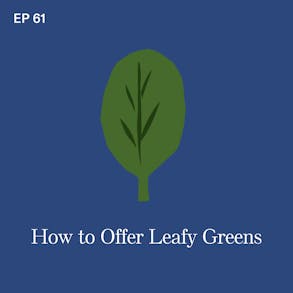
LISTEN TO THIS EPISODE
Episode Description
Can babies safely eat dark green leafy vegetables? Absolutely! It’s not safe for babies to eat raw greens or foods like lettuce or uncooked spinach or kale...but there are a number of ways you can safely prepare greens for baby-led weaning.
In this episode I’m sharing 5 easy ways to feed your baby dark green leafy vegetables. Greens contain unique flavors for your baby to try plus some valuable nutrients. And while plant based foods with iron (like the type in spinach and other greens) aren’t as easily absorbed by the body as animal foods, they’re still important foods for babies to eat (safely!)
Dive into this episode for 5 easy ways your baby can safely learn to eat greens!
Links from this Episode
- Baby-Led Weaning with Katie Ferraro program with the 100 First Foods™ Daily Meal Plan, join here: https://babyledweaning.co/program
- Baby-Led Weaning for Beginners free online workshop with 100 First Foods™ list to all attendees, register here: https://babyledweaning.co/baby-led-weaning-for-beginners

Latest Episodes
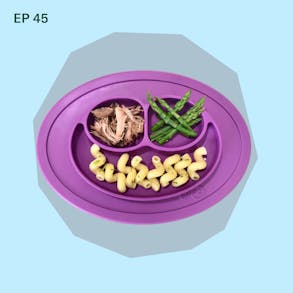
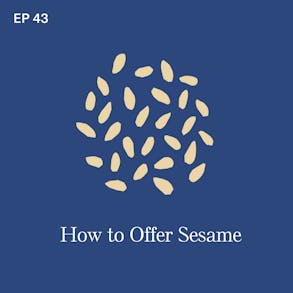


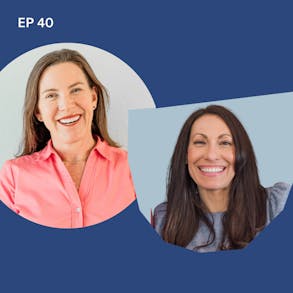
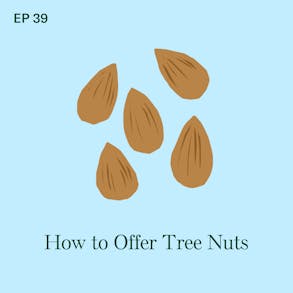
Katie Ferraro (1s):
How do I feed my baby lettuce or salad? We don't do it. Raw leafy green vegetables can be a choking hazard for babies. We want to see them cooked and I would love to see them prepared in a safe manner. That will not be a choking hazard for your baby. Hey there, I'm Katie Ferraro, Registered Dietitian, college nutrition professor, and mama of seven specializing in baby led weaning. Here on the Baby-Led Weaning Made Easy podcast I help you strip out all of the noise and nonsense about feeding, leaving you with the competence and knowledge you need to give your baby a safe start to solid foods using baby led weaning.
Katie Ferraro (41s):
You guys welcome back to another episode of the baby led weaning made easy podcast. Today, we're talking all about greens and in particular, dark green leafy vegetables. How do we safely feed them to the baby? I've got a tip of the day for you. As I like to start every episode with my baby led weaning tip is we don't feed babies, raw green vegetables. I'll get questions from parents. Like how do I feed my baby lettuce or salad? We don't do it. Raw leafy green vegetables can be a choking hazard for babies. We want to see them cooked. And I would love to see them prepared in a safe manner that will not be a choking hazard for your baby. That's the impetus for today's episode actually recently did a chopped style episode on the podcast where you guys gave me a ton of different recipe or ingredients or food ideas that you wanted to see prepared safely for babies.
Katie Ferraro (1m 31s):
And I was so surprised at how many of the submissions were dark green, leafy vegetables, to the point where I'm like, I need to do a whole separate episode on dark green, leafy vegetables. So that's what we're doing here today. I've got five easy ways for you to safely feed your baby greens. And before I dive into those, just a little bit about the nutritional value of leafy greens. Now they oftentimes represent bitter flavors, right? If we're talking about Swiss chard or kale, these are flavors that we're maybe not always inclined to feed our babies. And I oftentimes think of one of my favorite article headlines, wherever, right when I got into baby led weaning, there's this really snarky article, the title was your kale eating baby does not impress me.
Katie Ferraro (2m 14s):
And it was kind of a little tongue in cheek about how ridiculous some of the things about baby led weaning can be. But just the notion that a baby would eat kale. Sometimes parents were like, oh my gosh, kale, how can babies safely eat kale? Well, when we don't just feed babies, raw pieces of kale, right? That could be a choking hazard. Plus it's not very palatable. I mean, you and I don't even really like plain raw kale. Let's be honest. But when we think about kale, sometimes you'll see, for example, pouch products that are marketed to parents of small children and babies. And it'll say, oh, this is, you know, get your baby to eat kale. And if you actually look at the ingredients in some of these pouch products, what they basically are is applesauce or prune puree, or pear puree, a sweet food.
Katie Ferraro (2m 55s):
There's nothing wrong with fruits. But if we're using this familiar of a fruit to mask the taste of another bitter vegetable like kale, oftentimes these products just end up being like green colored apple sauce, which is 95% apples. And then 5% kale. That's not really a way to expose your baby to kale because they're not even tasting the kale they're tasting applesauce. That happens to have a small amount of kale on it. Appearance will think, oh, well, my baby's eating kale. I'm more of a fan of offering your baby, the actual dark green leafy vegetable in a format that they can learn to like and accept. We don't need to mask these flavors in sweet products like apple sauce. Again, there's nothing wrong with feeding your baby fruit on its own.
Katie Ferraro (3m 37s):
But when we're looking at the dark green leafy vegetables, let's make them the first ingredient or the forward tasting ingredients. So that babies learn to like, and accept them on their own. So let's dive right in five ways that you can safely feed your baby greens. And we're talking about greens. These are dark green, leafy vegetables, very nutritionally important. Yes. They've got those unique flavor profiles that we want babies to be exposed to, but greens are an important source of iron. And we know that the iron in plant foods like greens is not as well absorbed by the baby as our animal foods that contain iron. But the greens do contain other important nutrients, including iron that along with other nutrients, some of it can actually be absorbed by the body in greens, tend to have vitamin C in them.
Katie Ferraro (4m 18s):
And vitamin C helps your baby absorb iron from the other sources of food in their diet. So there's other beneficial nutrients in there. So we've got the flavor profile plus the nutrition profile, and we do want to be offering vegetables. In addition to fruit, as I mentioned, there's nothing wrong with fruit, but sometimes parents kind of run out of ideas for offering greens. So I hope this episode will help give you five ways that you can feed your baby greens. Let's go ahead and start with number one, a beet green pesto. A pesto is one of my favorite toppings for pastas, for babies, except that the pesto you would buy in the grocery store tends to be loaded with salt, but it's very easy to make your own pesto at home using the cooked chopped green, a lot of olive oil, you can use a little bit of Parmesan cheese just for some added flavor and put that on the pasta that your baby might already be eating.
Katie Ferraro (5m 7s):
Now, pasta is a wheat food, and wheat is one of the big eight allergenic foods. So you want to make sure that your baby's been exposed to wheat. A number of times without an allergic reaction before you would introduce like a beet green pesto and a pasta for the first time at the same time. So again, make sure babies had pasta. Add the beet green pesto, make a big batch of it. You can always add salt to the version that you're eating after you portion out the part for babies. It's one of the benefits of baby led weaning is that your baby can learn to eat modified versions of the same foods. The rest of your family is eating. So try making a pesto at home. It's surprisingly easy and a great way to incorporate greens. A second way that you can safely introduce greens is by making a fritter. I love fritters for baby led weaning.
Katie Ferraro (5m 48s):
These are little fried cakes or patties that babies can easily feed themselves. It's a great way to make some of those harder to feed whole grain foods, accessible babies, because little tiny pieces of grain, like let's say quinoa are impossible for early eaters to pick up. But if we fry them into a fritter that also incorporates a green, you can cut the fritters into strips about the size of your adult pinky finger. Serve that to the baby on babies have been eating for a little while, can even pick up the whole fritter and take off a bite. You could put something easily like Swiss chard into a fritter recipe that then the baby could eat a third way that you could do a green safely for babies is in an egg cup or an egg puff is what I sometimes call them.
Katie Ferraro (6m 28s):
We make them, I love to make egg cups in me, any muffin tins or in regular sized muffin. Tins. If you spray the muffin tin and you make a batter up with egg, a little bit of seasoning, you can put a half a cup or a cup of chopped collard greens. For example, in that egg batter, bake it. And that's the way you've incorporate egg with the greens. Now, egg is another allergenic food. You do wanna introduce egg by itself, a number of times without reaction, but once your baby's doing fine on that, and you're offering some of these combination foods, feel free to add grains like collard greens to an egg cup recipe as another safe way to feed your baby grains a fourth way that you can do leafy greens as, as part of a filling that would go in like a stuffed pasta. So for example, I love to make spinach manicotti for baby led weaning.
Katie Ferraro (7m 12s):
Manicotti just being the cooked egg or cooked noodle tubes. You could also do like cooked shells, or if your baby is eating combination foods, usually around nine or 10 months of age, once they've got the handle on all of the different single foods, you can then start offering combination foods with different textures and ingredients, even doing something like a lasagna, which could include spinach in that as well. I like to mix it with ricotta. Ricotta is one of my favorite ingredients for baby led weaning. It's surprisingly low in sodium. You can mix it with that cooked spinach, put it in the cooked pasta for a stuffed shell or stuffed pasta recipe. Again, not ideal for an early eater because you want to introduce each of those foods, the pasta and the ricotta individually on its own, as recipes would usually contain an egg as well.
Katie Ferraro (7m 57s):
If it's a potentially allergenic food, again, we offer it individually by itself a few time observing for any reaction. But once you know, your baby's able to tolerate that feel free for older babies to move on to combination foods like spinach manicotti and my final suggestion for a safe way to feed your baby leafy greens. This would be for older babies, but I love to make homemade kale chips. Now, kale again, sometimes a little cliche, like one of the most, you know, the quintessential health food. If you buy kale chips at the store, those are oftentimes processed with other ingredients that make them really, really crunchy and any dry crunchy food is certainly a choking hazard for a baby, but they tend to have a lot of added sodium as a snack food as well. But you can make these at home. I love to do a dry kale, do it on a cookie sheet where I spray the cookie sheet and then actually spray the kale with, if you have like an olive oil sprayer, I have one called the Misto.
Katie Ferraro (8m 46s):
I think it's like $5 on Amazon. I'll link to it in the show notes. For this episode, if you spray the olive oil onto the kale chips, you can bake them about, I do about hundred 25 degrees for about 15 or 20 minutes just before they kind of turn brown and get really, really crispy. They are great texture that kind of dissolves in the baby's mouth. It's kind of fun for them to play around with it, pick it up. They actually love homemade kale chips. So try that one out. If you guys are just getting started with the baby led weaning, I've got a free workshop for you with tons more ideas of how you can feed your baby a hundred different foods without you having to spoonfeed periods or buy pouches. It's called baby led weaning for beginners. I give everyone on this workshop, a copy of my 101st foods list.
Katie Ferraro (9m 29s):
I just gave you five ways to safely feed your baby five different greens got 95 other foods. Your baby can safely eat on that list. You can sign up for this week's workshop times. If you go to the show notes for this episode, I'll go ahead and link to the workshop. I'll also share a summary of the five different ways that I recommended feeding your baby greens with a brief outline of a recipe that you could incorporate if you're preparing foods for your own baby for baby led weaning. So go ahead and check out the show notes page for this episode at blwpodcast.com forward slash 61. That's where I've got the link to my free baby led weaning for beginners workshop, as well as the recipe outline for each of the five ways that I shared that you can safely feed your baby greens.
Katie Ferraro (10m 12s):
Thanks for listening guys. See you next time!
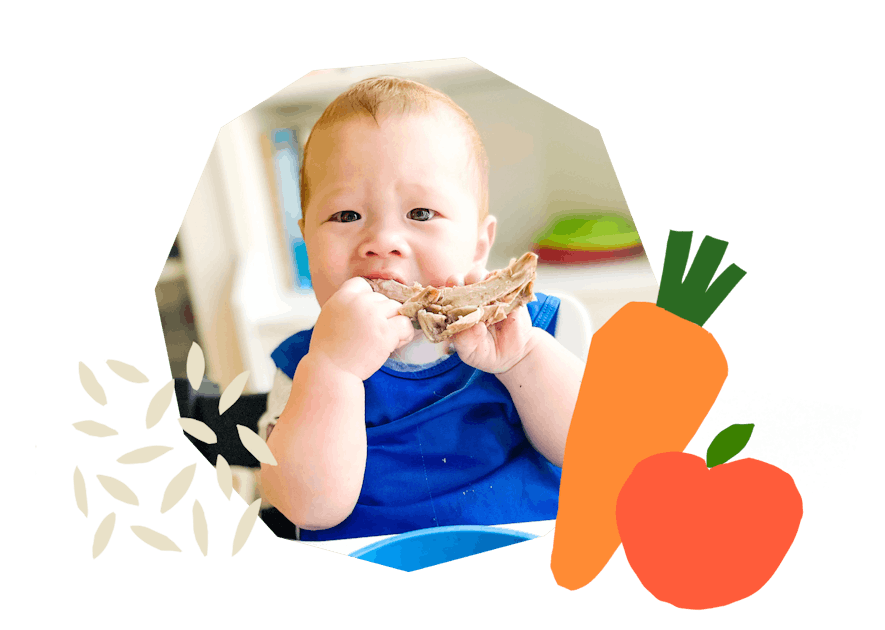
The Program Baby-Led Weaning with Katie Ferraro
A step-by-step digital program for starting solid foods safely and navigating the original 100 FIRST FOODS™ meal plan with baby-led weaning.
 EXPERT-LED, PROVEN APPROACH TO EATING REAL FOOD
EXPERT-LED, PROVEN APPROACH TO EATING REAL FOOD CONCISE VIDEO TRAININGS TO MASTER BABY-LED WEANING
CONCISE VIDEO TRAININGS TO MASTER BABY-LED WEANING 100 FIRST FOODS DAILY MEAL PLAN WITH FOOD PREP VIDEOS
100 FIRST FOODS DAILY MEAL PLAN WITH FOOD PREP VIDEOS
Baby-Led Weaning for Beginners Free Workshop
Is your baby ready to start solid foods, but you’re not sure where to start? Get ready to give your baby a solid foundation to a lifetime of loving real food…even if you’re feeling overwhelmed or confused about this next stage of infant feeding.
Get baby-led weaning recipes and tips delivered to your email inbox.

